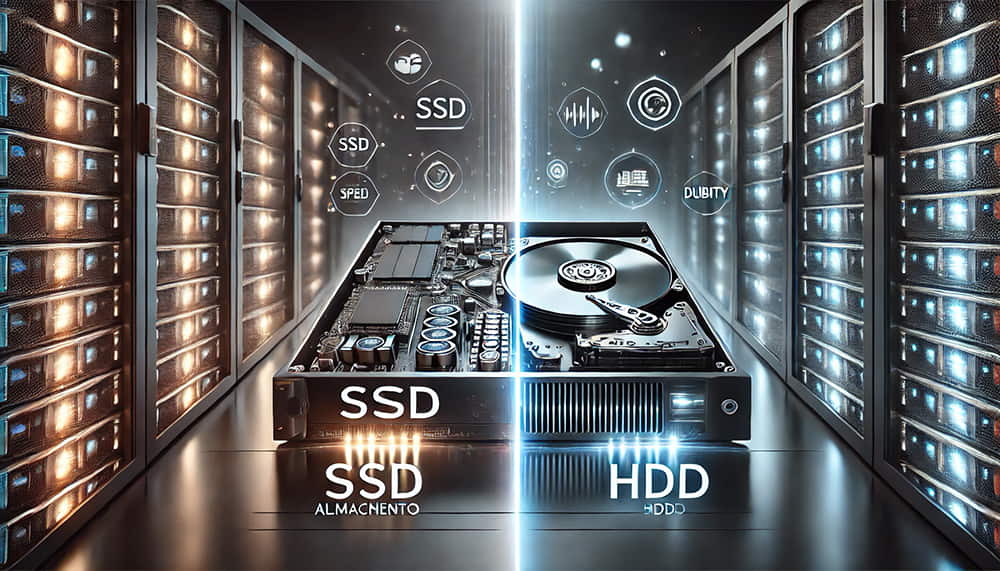Choosing the right storage type for a server is a crucial decision that impacts performance, capacity, and costs. SSDs (Solid State Drives) and HDDs (Hard Disk Drives) offer distinct advantages depending on the use case. In this guide, we look at the key differences, pros and cons, and when it’s best to opt for each technology.
Learn about all our servers at the following link.
What is an SSD and What is an HDD?
SSDs and HDDs are the main storage options in servers, but they work differently and are designed for specific needs.
Definition and operation of each technology
- HDD: They use rotating magnetic disks and a mechanical arm to read and write data. They have been the standard for decades.
- SSD: They have no moving parts, as they store data on flash memory chips, making them faster and more durable.
Comparison in terms of speed and capacity
- Speed: SSDs are significantly faster, with access times in the microseconds versus milliseconds for HDDs.
- Capacity: HDDs offer higher capacities at lower prices, making them ideal for storing large amounts of data for the long term.
Advantages and Disadvantages of SSDs and HDDs in Servers
Each technology has strengths and weaknesses that influence its suitability for different applications.
SSD: Speed and energy efficiency
Advantages:
- High read and write speeds, ideal for critical applications such as real-time databases.
- Lower energy consumption, which reduces operating costs in data centers.
- Shock and vibration resistance due to the absence of moving parts.
Disadvantages:
- Higher price per GB compared to HDDs.
- Lower maximum capacity available for mass storage needs.
HDD: Cost and mass storage capacity
Advantages:
- More affordable price, ideal for tight budgets.
- Capacities of up to 20 TB per unit, suitable for mass storage. massive.
Disadvantages:
- Slower speeds, which can affect applications that require frequent data access.
- Greater susceptibility to mechanical failures and less resistance to shock.
When to Choose SSD and When to Choose HDD
The choice between SSD and HDD depends on the purpose of the server and the specific performance and storage requirements.
Ideal Applications for SSD Storage
- Databases: The low latency of SSDs improves performance for frequent queries and large volumes of data.
- Virtualization: Acceleration of virtual machines and concurrent operations.
- Operating Systems and Critical Applications: To ensure fast boot times and snappy performance.
Use Cases Where HDD Is Still Relevant
- Backup Storage: Where speed is not critical and capacity is a priority.
- Multimedia Files: Ideal for large video or photo libraries.
- Surveillance Systems: To store continuous recordings for the long term.
Best Practices for Using SSDs SSD and HDD in Servers
Combining SSD and HDD can offer a balanced solution that maximizes performance and capacity while controlling costs.
Hybrid Combinations to Maximize Performance
- SSD-HDD Hybrids: Use SSD for frequently accessed data and HDD for mass storage.
- RAID: Configure RAID arrays to combine multiple drives and improve speed, redundancy, or both. For example, RAID 10 with SSD is ideal for critical databases.
Optimizing Disk Lifecycle
- SSD: Monitor wear using tools like CrystalDiskInfo and avoid filling disks to capacity to prolong their lifespan.
- HDD: Perform periodic defragmentation and monitor health with tools like SMART to prevent failures.
Choosing between SSD and HDD for servers depends on your priorities: speed and efficiency versus capacity and cost. By understanding the differences and adopting hybrid strategies, you can design a storage solution that balances performance and budget. Invest wisely and take your infrastructure to the next level!







